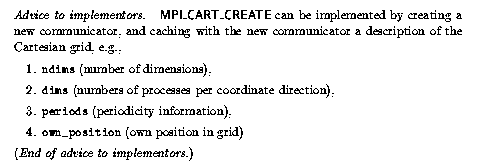
MPI_CART_CREATE can be used to describe Cartesian structures of arbitrary dimension. For each coordinate direction one specifies whether the process structure is periodic or not. For a 1D topology, it is linear if it is not periodic and a ring if it is periodic. For a 2D topology, it is a rectangle, cylinder, or torus as it goes from non-periodic to periodic in one dimension to fully periodic. Note that an n -dimensional hypercube is an n -dimensional torus with 2 processes per coordinate direction. Thus, special support for hypercube structures is not necessary.

MPI_Cart_create(MPI_Comm comm_old, int ndims, int *dims, int *periods, int reorder, MPI_Comm *comm_cart)
MPI_CART_CREATE(COMM_OLD, NDIMS, DIMS, PERIODS, REORDER, COMM_CART, IERROR)INTEGER COMM_OLD, NDIMS, DIMS(*), COMM_CART, IERROR
LOGICAL PERIODS(*), REORDER
MPI_CART_CREATE returns a handle to a new communicator to which the Cartesian topology information is attached. In analogy to the function MPI_COMM_CREATE, no cached information propagates to the new communicator. Also, this function is collective. As with other collective calls, the program must be written to work correctly, whether the call synchronizes or not.
If reorder = false then the rank of each process in the new group is identical to its rank in the old group. Otherwise, the function may reorder the processes (possibly so as to choose a good embedding of the virtual topology onto the physical machine). If the total size of the Cartesian grid is smaller than the size of the group of comm_old, then some processes are returned MPI_COMM_NULL, in analogy to MPI_COMM_SPLIT. MPI_COMM_NULL The call is erroneous if it specifies a grid that is larger than the group size.
